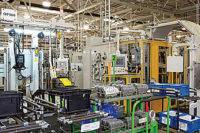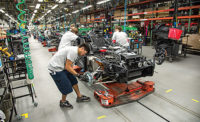Established in 2002, Polystar LLC produces a full line of chemicals for epoxies used in assembly applications. The company’s product line includes modifiers, curing agents, hardeners, diluents, adducted resins and related surfactants based on amine and epichlorohydrin chemistries.
Over the past decade, Polystar has grown in both size and chemistry complexity. Simultaneously, so has the need for the company to more closely control product consistency and safety. Aware of this, in late 2011, Polystar upgraded the automation at its main production plant in Dalton, GA, which operates 12 reactors ranging in size from 2,000 to 10,000 gallons.
Eric Kuckhoff, president of Polystar, says the key components of the upgrade are a Simatic PCS 7 process control system and several Sinamics variable-speed electric drives. Both products are made by Siemens Industry Inc.
Kuckhoff says the drives help Polystar lower its energy usage. The PCS 7 was chosen because its scalability increases plant flexibility in several areas.
“We started using the PCS 7 system with process monitoring, then moved it into automation control and added batch operations when we were ready,” says Kuckhoff.
The PCS 7 offers simultaneous operation of Profinet and Profibus in one controller, resulting in increased flexibility with reduced hardware. The system also increases productivity through vertical integration of office and automation areas. Integrated Ethernet interfaces reduce costs and eliminate the need for an additional communication module.
The PCS 7 has an advanced engineering feature that lets Polystar standardize interfaces and import data from any basic or detailed planning tools. Data from process tags or signal lists can be automatically adopted into the plant hierarchy, including object-based bulk processing. The system has a process historian, which Polystar uses to immediately access archived process tags, process alarms or batch data.
PCS 7 also has a process device manager that Polystar can use to instantly call up device or status information of intelligent process devices. Newly designed interfaces include easy-to-locate function keys.
Besides lowering energy usage, Sinamics drives provide service and maintenance benefits. Torque and current surges are reduced, helping stabilize a facility’s power grid. Additionally, the drives’ soft starting and stopping eliminate pressure surges that can cause damaging cavitation and vibration. Sinamics drives also do
not require any braking resistors because they feed the braking energy back into the line supply.
For more information on process control systems and electric drives, call 800-498-5351 or visit www.automation.siemens.com.
Automated Epoxy Plant Has More Flexibility
Established in 2002, Polystar LLC produces a full line of chemicals for epoxies used in assembly applications

Polystar LLC chose the Simatic PCS 7 process control system because its scalability increases plant flexibility. Photo courtesy Siemens Industry Inc.


